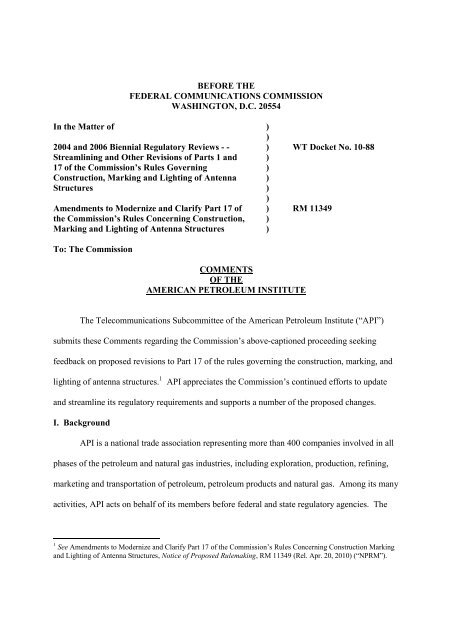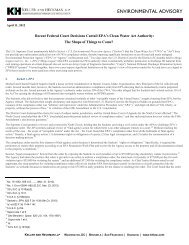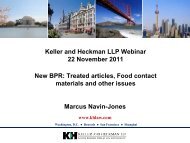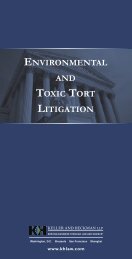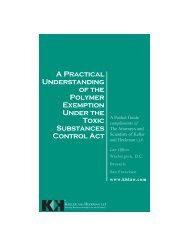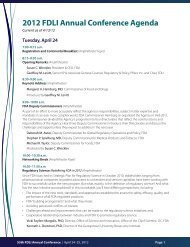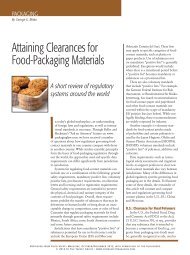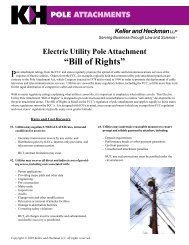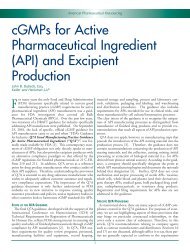Here - Keller Heckman
Here - Keller Heckman
Here - Keller Heckman
You also want an ePaper? Increase the reach of your titles
YUMPU automatically turns print PDFs into web optimized ePapers that Google loves.
BEFORE THE<br />
FEDERAL COMMUNICATIONS COMMISSION<br />
WASHINGTON, D.C. 20554<br />
In the Matter of )<br />
)<br />
2004 and 2006 Biennial Regulatory Reviews - - ) WT Docket No. 10-88<br />
Streamlining and Other Revisions of Parts 1 and )<br />
17 of the Commission’s Rules Governing )<br />
Construction, Marking and Lighting of Antenna )<br />
Structures )<br />
)<br />
Amendments to Modernize and Clarify Part 17 of ) RM 11349<br />
the Commission’s Rules Concerning Construction, )<br />
Marking and Lighting of Antenna Structures )<br />
To: The Commission<br />
COMMENTS<br />
OF THE<br />
AMERICAN PETROLEUM INSTITUTE<br />
The Telecommunications Subcommittee of the American Petroleum Institute (“API”)<br />
submits these Comments regarding the Commission’s above-captioned proceeding seeking<br />
feedback on proposed revisions to Part 17 of the rules governing the construction, marking, and<br />
lighting of antenna structures. 1<br />
API appreciates the Commission’s continued efforts to update<br />
and streamline its regulatory requirements and supports a number of the proposed changes.<br />
I. Background<br />
API is a national trade association representing more than 400 companies involved in all<br />
phases of the petroleum and natural gas industries, including exploration, production, refining,<br />
marketing and transportation of petroleum, petroleum products and natural gas. Among its many<br />
activities, API acts on behalf of its members before federal and state regulatory agencies. The<br />
1 See Amendments to Modernize and Clarify Part 17 of the Commission’s Rules Concerning Construction Marking<br />
and Lighting of Antenna Structures, Notice of Proposed Rulemaking, RM 11349 (Rel. Apr. 20, 2010) (“NPRM”).
API Telecommunications Subcommittee evaluates and develops responses to state and federal<br />
proposals affecting telecommunications facilities used in the oil and gas industries.<br />
API is supported and sustained by companies that make use of a wide variety of wireline,<br />
wireless and satellite communications services on both a private and commercial basis. API<br />
member companies are authorized by the Commission to operate facilities in the Private Land<br />
Mobile Radio (“PLMR”) service and Private Operational-Fixed Microwave Services (“POFS”),<br />
among other telecommunications systems.<br />
API’s members utilize PLMR systems, for example, to support the search for and<br />
production of oil and natural gas, to ensure the safe pipeline transmission of natural gas, crude oil<br />
and refined petroleum products, to process and refine these energy sources and to facilitate their<br />
ultimate delivery to industrial, commercial and residential customers. POFS is used for<br />
communications with remote oil and gas exploration and production sites for voice and data<br />
applications, communications with refineries, the extension of circuits to remote pipeline pump<br />
and compressor stations, and supervisory control and data acquisition systems (“SCADA”) that<br />
remotely monitor and control oil and gas wells, pipeline operations and other facilities.<br />
API member companies own thousands of communications towers and similar structures<br />
used for supporting radio antennas throughout the United States. The Commission’s proposed<br />
revision of Part 17 is of keen concern to API and its members.<br />
II. Comments Regarding Specific Proposals<br />
A. Codified Reference to Advisory Circular<br />
The Commission proposes to delete any reference to FAA Advisory Circulars as<br />
unnecessary and potentially confusing. 2 In the Commission’s view, “[s]uch references also may<br />
2 NPRM at para 12.<br />
2
cause confusion if the FAA updates the relevant circulars more frequently than the Commission<br />
amends its Part 17 rules.” 3<br />
Instead, the Commission proposes that structure owners be informed<br />
of lighting and marking requirements through the FAA and FCC registration processes. PCIA -<br />
The Wireless Infrastructure Association (“PCIA”) states that the FCC should clarify that lighting<br />
and marking requirements do not change unless the FAA recommends new specifications for<br />
particular structures. 4<br />
API supports the FCC’s proposal as modified by PCIA. API agrees that identifying a<br />
specific Advisory Circular in the rules could lead to confusion each time the FAA issues a new<br />
edition and also may result in an otherwise avoidable expenditure of Commission resources to<br />
update the codified reference in light of each new Advisory Circular. PCIA also is correct that<br />
confusion regarding the treatment of existing structures may result unless the Commission<br />
clarifies that a revised FAA Circular, by itself, does not impose new obligations upon alreadyapproved<br />
antenna structures.<br />
API disagrees that the Commission should apply new FAA marking and lighting<br />
standards retroactively to existing towers outside of the rulemaking process. 5<br />
At this point, the<br />
Commission can only speculate on the nature of any changes the FAA may make to its standards<br />
in the future. Without a specific proposal from the FAA, there is no information available to the<br />
Commission or the public regarding the scope or scale of future changes. The impact of such<br />
changes on previously existing towers is necessarily unknown. The Commission should rely on<br />
the rulemaking process in the event it seeks to apply standards retroactively to existing towers.<br />
3 Id.<br />
4 NPRM at para 12.<br />
5 Id.<br />
3
B. ASR Accuracy Requirements<br />
The Commission seeks comment on whether to amend its rules to require that the height<br />
information provided on FCC Form 854 be accurate within one foot and the coordinates<br />
provided in FCC Form 854 be accurate within one second of one degree longitude and latitude. 6<br />
The Commission also seeks comment on whether to require that antenna structure owners must<br />
use the most accurate data available when reporting height information and site coordinates, and<br />
whether a particular survey method should be specified. 7<br />
API supports the Commission’s proposal with respect to horizontal accuracy<br />
requirements of one second of one degree longitude and latitude. Regarding vertical accuracy,<br />
API recommends that the Commission allow for accuracy of 1 meter, instead of 1 foot.<br />
Accuracy to 1 foot is likely unnecessary and would be difficult to guarantee. In practice, even<br />
minor changes to a structure, such as the need to install a thicker concrete pad than anticipated<br />
during tower construction, could result in a change of one foot. Accuracy of 1 meter would be a<br />
more reasonable figure. 8<br />
API also recommends that the FCC not require any specific survey method. 9<br />
Specifying<br />
minimum accuracy standards will compel structure owners to use only those methods that can<br />
achieve the required level of accuracy. Specifying particular survey methods themselves would<br />
be duplicative and potentially restrictive as new, more advanced measurement technologies and<br />
practices are developed.<br />
6 NPRM at para 17.<br />
7 Id.<br />
8 Also, the Commission should clarify that height accuracy refers to height of the structure, not to ground elevation.<br />
Even the FAA’s 2A survey, which is rarely required, calls for a vertical accuracy of only 1 meter. Less stringent<br />
requirements typically used call for an accuracy of 6 meters or more.<br />
9 NPRM at para 17.<br />
4
C. Lighting Inspection Requirements<br />
The Commission proposes to delete the lighting inspection requirements in Section 17.47<br />
of the rules, or, alternatively, amend Section 17.47(b) to exempt certain systems using NOC<br />
center-based monitoring technologies from the requirement to inspect quarterly all automatic or<br />
mechanical systems associated with antenna structure lighting. 10<br />
API supports the Commission’s proposal to exempt certain systems using NOC centerbased<br />
monitoring technologies from the requirement to quarterly inspect all automatic or<br />
mechanical systems associated with antenna structure lighting. Technology has advanced to the<br />
point where such systems are often more effective than traditional visual inspection. Eliminating<br />
visual inspection for such systems will reduce the burden on tower owners and encourage tower<br />
owners to adopt state-of-the-art systems that will promote safe air navigation.<br />
D. Timeframe for Lighting Replacement<br />
The Commission proposes to require that antenna structure owners renew NOTAM<br />
submissions with the FAA in the event that lighting outages have not been corrected. 11<br />
This<br />
proposal is consistent with the FAA’s current requirement, and API supports the rule change.<br />
API strongly opposes, however, any modification to the rules to include timeframes for<br />
replacing or repairing extinguished lights notwithstanding the issuance of a NOTAM and urges<br />
the Commission to retain the requirement to repair lighting “as soon as practicable” as currently<br />
specified in Section 17.56. 12<br />
Tower lighting repair timeframes often depend on the accessibility<br />
of a tower to climbing crews. Weather conditions and seasonality are significant factors. In the<br />
rural and remote areas in which API’s members operate, towers may be inaccessible for several<br />
10 NPRM at para 25.<br />
11 NPRM at para 26.<br />
12 NPRM at para 27.<br />
5
weeks or more during the winter months. In the same vein, the availability of personnel<br />
qualified to climb and repair towers also is sometimes uncertain. An arbitrary timeframe for<br />
tower lighting repair will not serve to promote rapid tower repair above the requirement to<br />
replace lighting “as soon as practicable”. 13<br />
E. Record Retention Requirements<br />
The Commission proposes to amend Section 17.49 of its rules by requiring structure<br />
owners to maintain for two years and to provide to the Commission upon request records of<br />
observed or otherwise known extinguishments or improper functioning of structure lights. 14<br />
API<br />
supports the codification of a retention period and record production requirement but<br />
recommends that the retention period be limited to one year from the date that the lighting<br />
extinguishment or improper functioning structure lights was corrected. The FCC’s statute of<br />
limitations for purposes of imposing a forfeiture for violation of rules regarding lighting outages<br />
is one-year from the date the violation occurred. 15 There is no compliance benefit to require<br />
record keeping beyond the statute of limitations period to justify the additional record keeping<br />
burden on structure owners.<br />
F. Treatment of Voluntarily Registered Structures<br />
The Commission notes that some antenna structure owners have voluntarily registered<br />
their structures with the Commission, even though registration is not required because of height<br />
and/or location. 16<br />
The Commission seeks comments on whether 1) the rules concerning antenna<br />
structures should be enforced against such voluntarily registered structures, 2) owners of antenna<br />
13 The burden of renewing a NOTAM every 15 days during a light outage also serves as an incentive to remedy an<br />
issue as soon as practicable.<br />
14 NPRM at para 32.<br />
15 47 U.S.C. § 503.<br />
16 NPRM at para 39.<br />
6
structures that do not require registration should be prohibited from registering their towers, and<br />
3) antenna structure owners who have voluntarily registered structures should be required to<br />
withdraw their registrations from the Commission’s antenna structure database.<br />
API strongly opposes these changes. Voluntary tower registration results in a more<br />
complete database and is useful for structure owners, licensees and third parties. Voluntary<br />
tower registration can be used to supplement internal record keeping. Parties interested in<br />
leasing tower space also frequently use the ASR database to identify suitable structures.<br />
Wireless licensees and applicants use the ASR database to confirm coordinate and other tower<br />
information. Requiring or otherwise incentivizing the removal of voluntarily registered<br />
structures by threat of FCC enforcement in a way “punish” those who sought in good faith to<br />
provide additional information to the Commission and would be contrary to the public interest.<br />
The FCC’s suggestion that that the elimination of voluntarily registrations could reduce<br />
confusion concerning the regulatory status of these structures is misplaced. The regulatory status<br />
of a tower can be readily determined from the FAA aeronautical study number listed with each<br />
ASR.<br />
G. ASR Posting Requirements<br />
Currently, Section 17.4(g) of the Commission’s rules provides that an ASR number<br />
“must be displayed in a conspicuous place so that it is readily visible near the base of the antenna<br />
structure.” The Commission proposes to modify this rule to require that antenna structure<br />
owners display the ASR number so that it would be visible to a member of the general public<br />
who reaches the closest publicly accessible location near the base of the antenna. 17<br />
API supports this proposed rule change. Currently, Section 17.4(g) leads to confusion<br />
among tower owners in that it is not always possible to post an ASR number so that it is both<br />
17 NPRM at para 41.<br />
7
“readily visible” and “near the base” of the tower. The Commission has tried to alleviate this<br />
confusion by issuing “Posting Guidelines” that, among other scenarios, address towers that are<br />
located behind locked fences or on rooftops. API agrees that the proposed rule change will<br />
alleviate confusion and be beneficial to structure owners.<br />
III. CONCLUSION<br />
API supports the Commission’s efforts to update its antenna structure and lighting<br />
requirements and supports the adoption of rules consistent with the above comments.<br />
Respectfully submitted,<br />
THE AMERICAN PETROLEUM<br />
INSTITUTE<br />
By:<br />
__/s/ Jack Richards_______<br />
Jack Richards<br />
C. Douglas Jarrett<br />
Gregory E. Kunkle<br />
<strong>Keller</strong> and <strong>Heckman</strong> LLP<br />
1001 G Street NW<br />
Suite 500 West<br />
Washington, D.C. 20001<br />
(202) 434-4100<br />
Its Attorneys<br />
Date: July 20, 2010<br />
8


